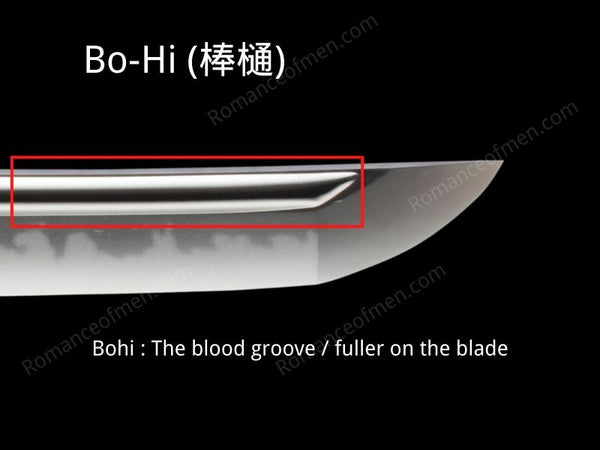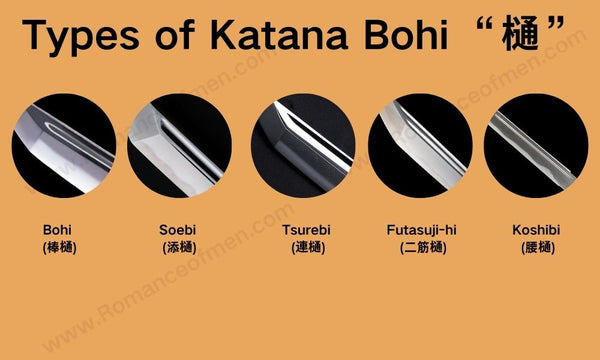Katana Bohi Things you should know about this part
Things You Need to Know About Bo-hi
Bo-Hi, also known as Hi, is a vital part of a Katana sword. Besides creating a visual appeal, it helps to lighten the Katana. So, you should know more about this excellent part of Katana. This guide will help you in this regard.
Table of Content
What is Bohi on a Katana?

Bohi refers to the groove or fuller on the katana blade. To be more accurate, in Japanese, Hi "樋" means groove, Hi is the general term for groove, and Bohi "棒樋" is a type of groove. But because Bohi was widely (somewhat incorrectly) used in English-speaking sword community, using bohi to refer to groove is now accepted, and we will keep using Bohi in this article to avoid confusion.
The purpose of Bohi is to reduce the katana weight without compromising the blade's durability. Additionally, it slightly moves the Katana's equilibrium state towards the Tsuba. As a result, it increases the sword's cutting speed and lightness. It made it simpler to control during combat. It also had the benefit of rendering the blade more aerodynamic, thereby improving its cutting ability.
What's the Usage of Bo-Hi?
While there are no historical documents that describe the purpose of the Bohi, The commonly accepted theory are:
Reducing the weight of the blade
Bohi contributed to the sword's weight reduction from a functional perspective. This theory was long questioned but has been proved in recent years.
There were experiments, using a katana without bohi, gradually carving a bohi into it, and measuring its strength with machine. The results shows that while the strength of a blade with a bohi is slightly inferior to that of a blade without one, there is no significant change in performance.
Enhancing appearance
The Katana Bo-Hi increased the sword's aesthetic appeal and enhanced its intimidating appearance. A blade with Bohi appears slimmer compared to one without it. The flowing curves along the blade enhance the beauty of the Japanese sword, making katana with bohi more popular among Katana fans.
Facilitating the whistling sound
When you swing your katana properly, with correct edge alignment, you will naturally hear the "hyu" sound. This is called “Tachi-Kaze” 太刀風, means sound of air being "sliced" by the cut. A katana with bohi is easiler to produce this sound, it will help you better understand the speed and angle of your cut. Some said in ancient Japan, this sound helps intimidate the opponents and gain an advantage in combat.
Disadvantage of Bohi
The main disadvantage of having a bohi is that it makes the katana more difficult to clean and maintain. Dirt can easily get stuck in the groove, making it hard to remove. Additionally, a katana with a bohi is harder to repair, especially if it bends, because the groove makes the blade more prone to twisting.
Types of Bohi

Bohi (棒樋): This is the most common type of hi, consisting of a single, long groove carved along the length of the blade. It is found on various types of Japanese blades, including Uchigatana (打刀), Wakizashi (脇差) and Tanto (短刀).
Soebi (添樋): A thinner groove that runs parallel to the main bohi. It is carved along the blade and enhances the visual appeal while maintaining the structural integrity of the sword.
Tsurebi (連樋): Similar to soebi but extends to the very end of the main bohi, making it slightly longer. It's a distinguishing feature because it follows the length of the bohi all the way to its end.
Futasuji-hi (二筋樋): Features two grooves of the same thickness, carved parallel along the blade. This type not only adds to the blade's strength but also has religious significance, often representing sacred objects.
Koshibi (腰樋): A shorter hi carved near the base of the blade, typically on the lower third of the sword (near the "waist" of the blade). This type is often seen on weapons like Naginata.
In our custom katana section, you can choose different types of bohi.
Common Questions About Bohi
Bohi is used to drain blood
Because Bohi is also known as blood groove, there is a myth that the swordsmiths create this groove for fluid to drain to prevent blood from dripping and making the Katana handle slippery. But these are just myths, the only practical purpose of bohi is weight reduction.
However, as mentioned early, dirts and blood could get stuck in the bohi and cause the blade rust. To prevent that, in ancient Japan samurai will coated Bohi with red lacquer. This is more common for Yari (槍).

Do traditional katana have Bohi
Not all katana features Bohi. The inclusion of a bohi is a design choice that affects the sword's weight, balance, and aesthetic qualities. But it's not mandatory.
Will bohi weaken the blade
Actually not, while a bohi slightly reduces the material strength of the blade, it is generally not enough to be considered a weakness under normal usage for which the sword is designed.
Will a Badly Done Bo-Hi Impact Performance?
Yes, if excessive material is removed, not if the Bo-Hi is just badly finished in appearance.
Will two or 1.5 blood grooves remove far too much metal from the Katana, rendering it too delicate?
No, the Bo-Hi will make no difference to the overall durability of the katana sword when it’s done correctly by a good craftsman.
Conclusion
Contemporary martial artists who do numerous katas or demonstrations frequently prefer Bo-Hi. Thanks for reading through. Hopefully, you've found this article helpful. Have a fantastic day! Don't forget to check our katana anatomy guide here.






















Thank you.
Serban